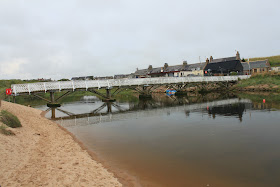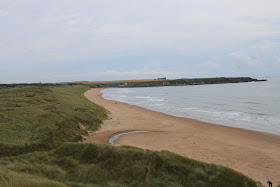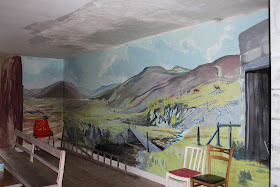Despite the promise to myself last week that I would get some height under my boots this week, circumstances conspired against me. These circumstances meant that Mo and I were in Cruden Bay with the chore of walking the two dogs that belong to our son and his partner. I say chore but that's probably too strong a word since it implies that it's something I don't want to do when in fact it's something that, given a choice, I wouldn't necessarily have chosen to do today. The problem I think is that I'm not, and never have been, a pet person. I simply don't get it. Dogs are dogs; they are animals, a bit cuter than some no doubt, but animals never the less. They are not little people and I dislike intensely the way some owners try to "humanise" them or make out that they are somehow something other than animals. However enough of my prejudices, I know that I'm actually the weirdo and in the minority of about one. There is of course an upside to walking the dogs at Cruden Bay and that is we could walk them on the beach. Not only that but the footbridge across the Water of Cruden, (Ladies Bridge), linking the village of Port Errol to the beach has been refurbished and reopened meaning the beach is accessible again without dodging golf balls!
 Access Bridge
Access BridgeThe tide was well in when we set off making walking in the soft part of the sand a wee bit uncomfortable underfoot. Once we cleared the first bend though we made our way down to the water's edge and it all became a bit easier. I like to think that Cruden Bay, (or Bay of Cruden according to the O&S map), is the last part of the dune system that starts at the mouth of the River Don. But there's a fair gap between the end of the dunes at the Forvie Sands Nature Reserve and the southern end of the bay, so maybe I'm kidding myself on. The beach today was relatively quiet, as you might expect on a Friday, but there were still the occasional dog walkers and at least one family looking for a picnic spot out of the wind. As for taking photos, I decided that I needed to gain some height so I, with the dogs but not Mo in tow, climbed the highest of the dunes to try for some perspective.
 Looking North
Looking North Looking South
Looking SouthWhile I was perched on the top of this sand dune I also took some photographs of Cruden Bay golf course and found myself faced with a crisis of conscience. The problem is that I used to play a bit of golf. Not to any great standard but well enough to enjoy the day out, even if it was only for the walk and the company. In my time of playing I played some very classy courses - St Andrews, (Old and New), Nairn, Lossiemouth, Carnoustie, Ladybank and Downfield to name but a few. But Cruden Bay for me was the best, not necessarily as a test of golf, (although it beat me up every time I played), but as a fabulous place to walk and socialise and occasionally find my ball after hitting it.
 Cruden Bay Golf Course
Cruden Bay Golf CourseSo having extolled the golf course and all its glories why is it that I go into such a rage when I read about an arrogant, egotistical American billionaire with a hair fixation and dubious Scottish ancestry flying in and declaring that he's going to build the "world's best golf course" on what is the Mennie Estate a mere 10miles or so south of where I now stood? Could it be the fawning, crawling, money grabbing business people of Aberdeen who have shown no subtlety at all in their courting of the man? Or maybe it's our elected representatives in Edinburgh who are obviously all for democracy, as long as the great unwashed make the right decision. So when the local planning committee said go away and think again, the Government "called it in". For our own good you understand and just to make sure we got the decision we should have made for ourselves in the first place. Or maybe it's the treatment of the people already living on the estate who, when they refused to sell up and move, were threatened first with compulsory purchase then, when that was withdrawn under massive public pressure, are now being harassed with "landscaping" work going on around their properties. Or maybe it's the fact that the dune system on the Mennie estate is a world class site and is of course protected as a Site of Special Scientific Interest. It seems that the rules protecting such sites are only valid as long as they don't interfere with progress. I'm sure I could make a case for all of these giving me cause to rant, but I think principally it's because it's all a con. Everybody talks about the "best golf course in the world" but nobody talks about the hotel and the 1500 houses, including the four story flats, the carparks and everything else that goes with a leisure complex of this size. It seems though that money talks and the hotel, houses and golf course will happen. But perhaps the greatest irony is that the "best golf course in the world" will not be the best golf course in Scotland and is even unlikely to be the best golf course in Aberdeenshire.
Anyway enough of political ranting and back to our walk along the sands of Cruden Bay. The weather was pleasant with a warm offshore breeze. We spotted a couple of seals who watched us pass and we wondered if they seen us as a threat or if they were just curious about a couple of old dears and their dogs. By the time we reached the end of the bay we had the beach to ourselves apart from a young couple who had passed us earlier. They carried on around the rocky inlet shown on the O&S map as Craig Andrew but we decided that it was time to head back. I understand that this part of the coast had been a prime candidate for a German invasion during the second world war, (hence the derelict listening post on Goats Hillock just south of Slains Castle). There is little left to see apart from concrete blocks lining the beach, some of which appear to form part of a sea wall protecting the golf course. There are however some more obvious signs.
 Coastal Defences
Coastal DefencesFrom here it was an easy walk back to the car. In all we had been out for a couple of hours and if you're ever in the area and looking for an afternoon stroll I would recommend it.
If you want more information on the Trump housing estate and golf course, and if you have a wee while to spare, I can recommend reading this Report
J
More Photos















































